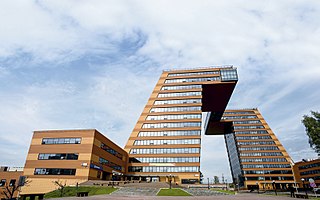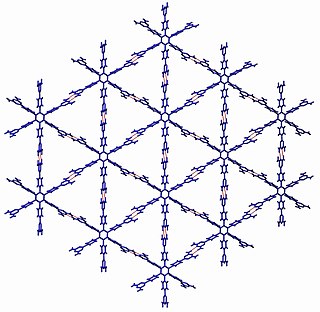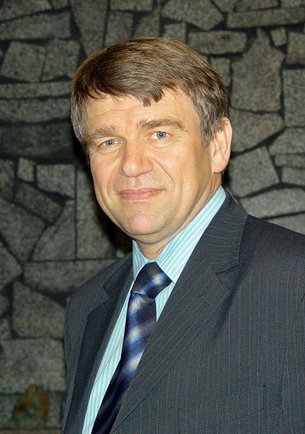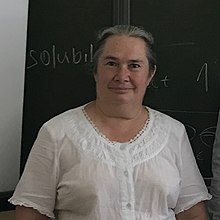
Akademgorodok is a part of the Sovetsky District of the city of Novosibirsk, Russia, located 30 km (19 mi) south of the city center and about 10 km (6.2 mi) west of Koltsovo. It is the educational and scientific centre of Siberia.

In materials science, a single crystal is a material in which the crystal lattice of the entire sample is continuous and unbroken to the edges of the sample, with no grain boundaries. The absence of the defects associated with grain boundaries can give monocrystals unique properties, particularly mechanical, optical and electrical, which can also be anisotropic, depending on the type of crystallographic structure. These properties, in addition to making some gems precious, are industrially used in technological applications, especially in optics and electronics.
Silver molybdate (Ag2MoO4), a chemical compound, is a yellow, cubic crystalline substance often used in glass. Its crystals present two types of electronic structure, depending on the pressure conditions to which the crystal is subjected. At room temperature, Ag2MoO4 exhibits a spinel-type cubic structure, known as β-Ag2MoO4, which is more stable in nature. However, when exposed to high hydrostatic pressure, the tetragonal α-Ag2MoO4 forms as a metastable phase.

Crystal engineering studies the design and synthesis of solid-state structures with desired properties through deliberate control of intermolecular interactions. It is an interdisciplinary academic field, bridging solid-state and supramolecular chemistry.

CrystEngComm is a peer-reviewed online-only scientific journal publishing original research and review articles on all aspects of crystal engineering including properties, polymorphism, target materials, and crystalline nanomaterials. It is published biweekly by the Royal Society of Chemistry and the editor-in-chief is Pierangelo Metrangolo. According to the Journal Citation Reports, the journal has a 2020 impact factor of 3.545. CrystEngComm has a close association with the virtual web community, CrystEngCommunity.

A molecular solid is a solid consisting of discrete molecules. The cohesive forces that bind the molecules together are van der Waals forces, dipole-dipole interactions, quadrupole interactions, π-π interactions, hydrogen bonding, halogen bonding, London dispersion forces, and in some molecular solids, coulombic interactions. Van der Waals, dipole interactions, quadrupole interactions, π-π interactions, hydrogen bonding, and halogen bonding are typically much weaker than the forces holding together other solids: metallic, ionic, and network solids. Intermolecular interactions, typically do not involve delocalized electrons, unlike metallic and certain covalent bonds. Exceptions are charge-transfer complexes such as the tetrathiafulvane-tetracyanoquinodimethane (TTF-TCNQ), a radical ion salt. These differences in the strength of force and electronic characteristics from other types of solids give rise to the unique mechanical, electronic, and thermal properties of molecular solids.
Acta Crystallographica is a series of peer-reviewed scientific journals, with articles centred on crystallography, published by the International Union of Crystallography (IUCr). Originally established in 1948 as a single journal called Acta Crystallographica, there are now six independent Acta Crystallographica titles:

Yurii Shaevich Matros was a scientist in the field of chemical engineering, known for his achievement in the theory and practice of heterogeneous catalytic processes. He is acknowledged as a “Godfather” of realization of catalytic processes in forced unsteady state conditions. Matros developed a catalytic reactor with periodic changes of direction of flow rate in packed bed of catalyst. This reactor is widely known in scientific and applied literature as an example of an application of developed theory of forced unsteady processes. Yurii Matros possessed a full doctoral degree of science and was a professor.
Vladimir Aleksandrovich Sobyanin is a Russian/Soviet scientist, PhD, and professor.
Pierangelo Metrangolo is an Italian chemist with interests in supramolecular chemistry and functional materials. He also has an interest in crystal engineering, in particular by using the halogen bond. He is Vice-President and President-Elect of the Physical and Biophysical Chemistry Division of IUPAC.

Valentin Nikolayevich Parmon is a Russian scientist who is credited with inventing new and improved catalytic processes in the field of energy technology.
Konstantin P. Bryliakov is a Russian chemist and author of monographs and over 170 research papers, textbooks, and patents. He is a professor at Russian Academy of Sciences and Novosibirsk State University.

Sovetsky District is an administrative district (raion), one of the 10 raions of Novosibirsk, Russia. It is located on the right and left banks of the Ob River. The area of the district is 89,2 km2. Population: 141,911.

CrystalExplorer or CE is a freeware designed to analysis the crystal structure with *.cif file format.

Diiodoacetylene is the organoiodine compound with the formula C2I2. It is a white, volatile solid that dissolves in organic solvents. It is prepared by iodination of trimethylsilylacetylene. Although samples explode above 80 °C, diiodoacetylene is the most readily handled of the dihaloacetylenes. Dichloroacetylene, for example, is more volatile and more explosive. As confirmed by X-ray crystallography, diiodoacetylene is linear. It is however a shock, heat and friction sensitive compound. Like other haloalkynes, diiodoacetylene is a strong halogen bond donor.

Mary Anne White is a Canadian materials scientist who is the Harry Shirreff (Emerita) Professor of Chemical Research at Dalhousie University. Her research considers novel solar thermal materials and their application in renewable energy devices. She is the author of a textbook titled Physical Properties of Materials. She was appointed an Officer to the Order of Canada in 2016.
Robert Day Shannon is a retired research chemist formerly at DuPont de Nemours, Inc.
Susan Reutzel-Edens is an American chemist who is the Head of Science at the Cambridge Crystallographic Data Centre. Her work considers solid state chemistry and pharmaceuticals. She is interested in crystal structure predictions. She serves on the editorial boards of CrystEngComm and Crystal Growth & Design.











